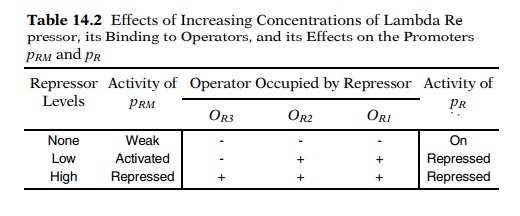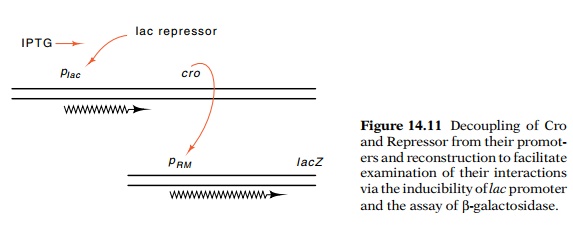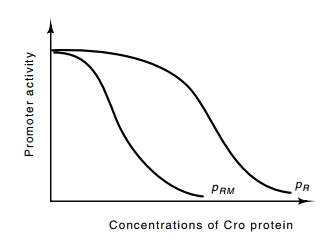Chapter: Genetics and Molecular Biology: Lambda Phage Genes and Regulatory Circuitry
Site for Cro Repression and CI Activation
Site for Cro Repression and CI Activation
Regulation
of the early promoters is more complicated than has been indicated. At both pL and pR are three binding sites for both Cro and repressor, OL1, OL2, and OL3
on the left, and OR1, OR2, and OR3 on the right. Repressor bound at OL1 is sufficient to
inactivate pL. Repressor

and Cro
binding on the right is more interesting and complicated because there these
proteins regulate the activities of both pR
and pRM.
Table 14.2 Effects
of Increasing Concentrations of Lambda Re-pressor, its Binding to Operators,
and its Effects on the Promoters pRMand pR

stimulator
or, at higher concentrations, as a repressor for pRM(Table 14.2). These different activities are
accomplished by the follow-ing means. Repressor bound at OR1 inactivates pR,
but repressor bound at OR1
and OR2 simultaneously
represses pR and activates
pRM. Repressor bound at OR3 inactivates pRM. Cro protein bound at OR3 represses pRM, and Cro bound to OR1 or OR2 represses pR
(Table 14.3).
Despite
the fact that Cro and repressor bind to virtually the same sequences, at least
as assayed by DNAse protection and the behavior of mutations lying in the three
operator sites on the right, their binding is not the same. As the level of Cro
begins to rise in cells, for example during a lytic infective cycle, Cro binds
first to OR3 and shuts off
the synthesis of CI repressor. Only later, after the level of Cro has risen
still higher, does it bind to OR2
and OR1 and shut down the
activity of pR. On the
other hand, during a phage developmental cycle that will result in the
production of a lysogen, as repressor begins to accumulate it first binds to OR1 and OR2 and shuts off pR
and turns on pRM. At still
higher concentrations, repressor binds to OR3
and shuts off pRM. The
basis for the differential affinity of repressor and Cro for the three
operators lies in the slight sequence differences among the sites and the
structural
Table 14.3 Effects
of Increasing Concentrations of Cro Protein, itsBinding to Operators, and its
Effects on the Promoters pRM
and pR


We owe
the preceding picture to a series of clever in
vivo and in vitro experiments by
Ptashne and his collaborators. Two operations had to be performed to examine
the in vivo effects of Cro and
repressor on the activities of pR
and pRM. The synthesis of
the two proteins had to be decoupled and a means had to be found of varying the
level of one protein while examining the activity of each of the promoters.
Genetic engineering came to the rescue. In one case Cro protein synthesis was
placed under control of the lac
promoter via a plac-cro
fusion (Fig. 14.11). Since the lac
promoter was still regulated by lac
repressor, the level of Cro in cells could be varied by varying the
concentration of lac inducer, IPTG,
added to the culture medium. Quantitating the activities of pR and pRM was facilitated by fusing either promoter to the β-galactosidase gene. Hence,
although IPTG was added to cells and β-galactosidase was measured, the results elucidated
behavior not of the lac operon, but
of lambda phage.
As the
intracellular concentration of Cro was increased, first pRM and then pR
was repressed (Fig. 14.12). These promoters showed much
Figure
14.12 Response of thepRand pRM promoters to increasing concentrations of Cro
protein.

different
responses to repressor (Fig. 14.13). At one concentration, pR was shut off and pRM
was turned on. Then, at higher concentrations, pRM was shut off as well. In vitro transcription experiments using DNA fragments several
hundred base pairs long yielded the same results.

Quantitation
of the binding of Cro and repressor to the three opera-tors was done with DNAse
footprinting. At the lowest Cro concentra-tions, only OR3 is occupied, but as Cro levels are increased, OR2 and OR1 become occupied as well. The results with repressor
are the reverse. OR1 has
the highest apparent affinity for repressor, being 50% occupied at a
concentration of 3 nM in vitro. At
twice this concentration, OR2
is 50% occupied, but 25 times this concentration is required for OR3 to be 50% occupied.
Related Topics